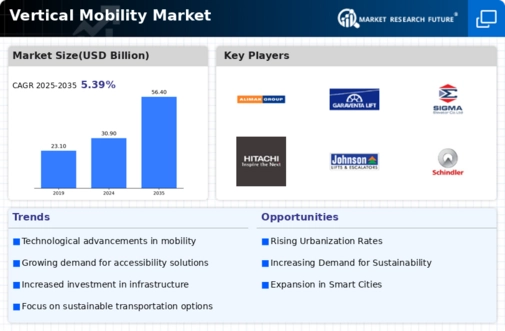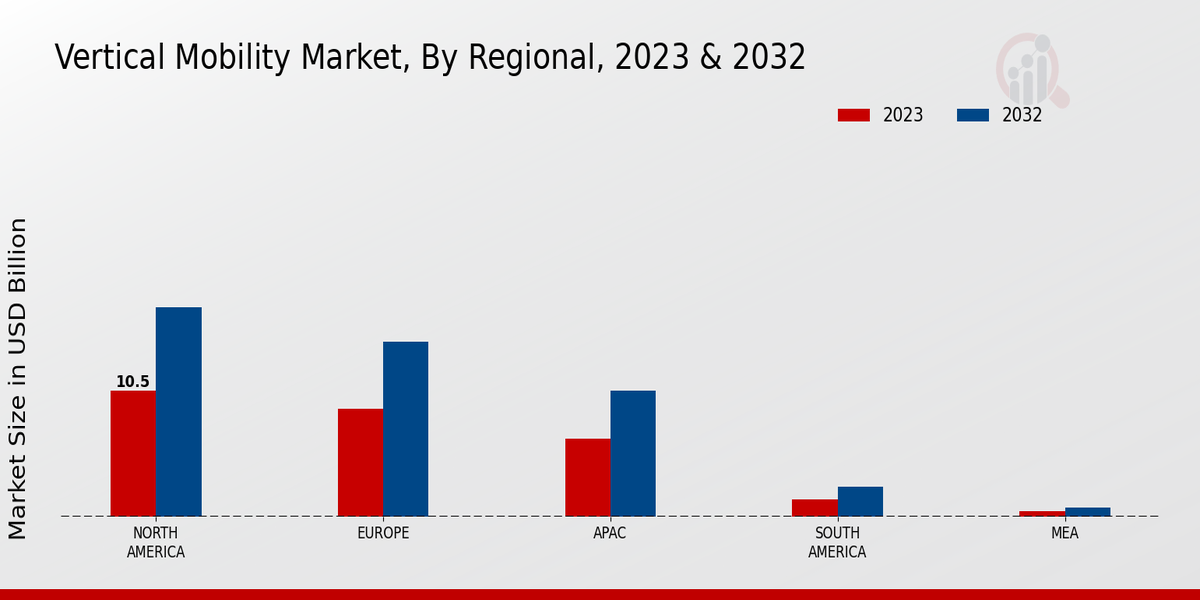Aging Population
The aging population is a significant demographic factor driving the Global Vertical Mobility Market Industry. As the global population ages, there is a growing need for mobility solutions that cater to the elderly and those with mobility challenges. Vertical mobility systems, such as stairlifts and platform lifts, provide essential support for individuals with limited mobility, enhancing their independence and quality of life. This demographic shift is likely to increase demand for such systems, prompting manufacturers to innovate and adapt their offerings. Consequently, the market is poised for growth as it addresses the specific needs of an aging society.
Urbanization Trends
The rapid urbanization across the globe is a primary driver for the Global Vertical Mobility Market Industry. As cities expand and populations increase, the demand for efficient transportation solutions rises. Urban areas are projected to house 68 percent of the world population by 2050, necessitating innovative mobility solutions. This trend is likely to propel the market, as vertical mobility systems such as elevators, escalators, and vertical lifts become essential for navigating densely populated environments. The Global Vertical Mobility Market is expected to reach 30.9 USD Billion in 2024, reflecting the urgency for advanced mobility infrastructure in urban settings.
Market Growth Projections
The Global Vertical Mobility Market is projected to experience substantial growth, with expectations of reaching 30.9 USD Billion in 2024 and 56.4 USD Billion by 2035. The compound annual growth rate is estimated at 5.62% from 2025 to 2035, indicating a robust expansion trajectory. This growth is driven by various factors, including urbanization, technological advancements, sustainability initiatives, and demographic shifts. The market's evolution reflects the increasing importance of vertical mobility solutions in modern urban environments, emphasizing the need for innovative and efficient transportation systems.
Infrastructure Development
Infrastructure development is a vital driver of the Global Vertical Mobility Market Industry. Governments and private sectors are investing heavily in modernizing urban infrastructure, which includes the integration of advanced vertical mobility systems. Projects such as smart cities and high-rise buildings necessitate efficient vertical transportation solutions to enhance accessibility and convenience. As urban planners prioritize vertical mobility in their designs, the market is expected to flourish. The anticipated growth in infrastructure investments is likely to support the market's expansion, aligning with the projected increase in market value to 56.4 USD Billion by 2035.
Sustainability Initiatives
Sustainability initiatives are increasingly influencing the Global Vertical Mobility Market Industry. Governments and organizations worldwide are prioritizing eco-friendly solutions to reduce carbon footprints. Vertical mobility systems that utilize renewable energy sources or energy-efficient technologies align with these sustainability goals. For example, regenerative drives in elevators can significantly lower energy consumption. As regulations become stricter and public awareness grows, the demand for sustainable vertical mobility solutions is likely to increase. This shift could contribute to a compound annual growth rate of 5.62% from 2025 to 2035, underscoring the market's potential in supporting global sustainability efforts.
Technological Advancements
Technological innovations play a crucial role in shaping the Global Vertical Mobility Market Industry. The integration of smart technologies, such as IoT and AI, enhances the efficiency and safety of vertical mobility systems. For instance, predictive maintenance powered by AI can reduce downtime and improve service reliability. Furthermore, advancements in energy-efficient designs and materials contribute to sustainability goals, appealing to environmentally conscious consumers. As these technologies evolve, they are expected to drive market growth, with projections indicating a market value of 56.4 USD Billion by 2035, highlighting the transformative impact of technology on vertical mobility.








